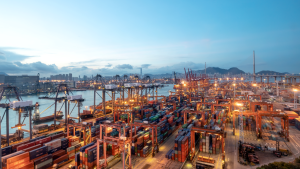President Donald Trump sees tariffs as a means to reduce trade deficits, encourage domestic manufacturing and address national security concerns. By imposing tariffs, Trump aims to make foreign goods more expensive, thereby promoting the purchase of American-made products. This approach is intended to decrease reliance on imports, and generate revenue for the government. But who really pays for tariffs? Critics argue that such measures can lead to higher consumer prices and potential trade disputes.
Reasons Why Trump Wants Tariffs
Tariffs are taxes on imported goods that make foreign products more expensive than domestic ones. Although importers pay the tariff, they usually raise prices for consumers to cover the cost. And this can influence buying decisions by encouraging consumers to choose locally made products.
Historically, tariffs were a key source of federal revenue and supported U.S. industry, especially in the 19th century. But since World War II, the U.S. has moved toward lower tariffs and more global trade. While tariffs can help protect certain industries, they may also raise consumer costs and trigger trade disputes. Their impact depends on how they’re applied and how other countries react.
So, why does Trump want tariffs? The president’s push for tariffs stems from a blend of economic nationalism, skepticism of global trade deals and a desire to reorient U.S. trade policy toward self-sufficiency. His approach reflects a belief that tariffs can be used strategically. He wants to defend U.S. industries and reshape international relationships to reduce economic dependencies. Several distinct motivations underpin his tariff strategy. Here are four main reasons why Trump wants tariffs.
Reducing the Trade Deficit
Trump has consistently pointed to the U.S. trade deficit—especially with China—as a sign of economic imbalance. In his view, large trade deficits reflect lost American jobs and weakened domestic production. By raising the cost of imported goods, tariffs are designed to reduce demand for foreign products. In theory, this encourages consumers and businesses to buy American, thereby shrinking the deficit over time.
Revitalizing U.S. Manufacturing
A core promise of Trump’s economic agenda has been to bring manufacturing jobs back to the U.S. Tariffs target industries such as steel, aluminum and machinery, where foreign competitors often undercut domestic producers. By making imports more expensive, the goal is to give U.S.-based manufacturers a price advantage. As a result, he hopes to incentivize companies to relocate production to American soil.
Countering Unfair Trade Practices
Trump has argued that some countries engage in unfair trade tactics—such as subsidies, currency manipulation and intellectual property theft—that distort global markets. Tariffs serve as a retaliatory measure meant to pressure these countries into negotiating fairer trade terms. His administration used this approach extensively in trade disputes with China, Mexico and the European Union.
Targeting Immigration and Drug Trafficking
Trump has employed tariffs as leverage to address immigration and drug trafficking concerns, particularly with Mexico. In 2025, he imposed 25% tariffs on Mexican imports until Mexico took stronger actions against illegal immigration and fentanyl. This strategy aims to pressure neighboring countries by tying economic consequences to their border enforcement efforts.
What Do Economists Think About Trump’s Tariffs?

Many economists express concern over President Trump’s tariff policies, highlighting potential risks to both the U.S. and global economies. The Penn Wharton Budget Model projects that the tariffs introduced in April 2025 could reduce U.S. GDP by approximately 6% and wages by 5%, with a middle-income household facing a lifetime loss of around $22,000. Similarly, the Tax Foundation estimates that a 10% universal tariff would reduce GDP by 4%, a 15% universal tariff would reduce GDP by 6%, and a 20% universal tariff would reduce GDP by 8%.
While economists like Art Laffer view the tariffs as a strategic negotiating tool, the prevailing sentiment among experts is less optimistic. Most argue tariffs may lead to higher consumer prices, reduced economic growth and potential long-term damage to the U.S.’s global economic standing. The unpredictability of the trade policies adds to the challenges faced by businesses and investors.
Why Trump Uses the Gilded Age as a Model for Tariffs
Trump has cited the Gilded Age (1870–1913) as an economic model when signing new executive orders to raise tariffs. He praises this era for industrial growth and wealth, especially under President William McKinley, and claims tariffs were key to U.S. prosperity before the income tax was introduced. Trump argues that modern tariffs can boost domestic manufacturing, reduce federal debt and possibly replace income taxes.
Historians and economists, however, challenge this view, noting that while the late 19th century saw economic expansion, it also involved severe inequality, poor working conditions and political corruption. They argue growth came more from immigration, resource extraction and industrialization than tariffs.
Since revitalizing U.S. manufacturing is a core reason for raising tariffs, the table below compares working class conditions in the Gilded Age (1870–1913) with the first quarter of the 21st century:
| Category | Gilded Age (1870–1913) | 2000s (2000–2025) |
|---|---|---|
| Work Conditions | Long hours (10–16/day), dangerous, no protections | Regulated hours, workplace safety laws, OSHA standards |
| Wages | Low, often below subsistence | Higher nominal wages; varies by industry and region |
| Labor Rights | Minimal legal rights, no federal minimum wage | Federal and state labor laws, minimum wage in place |
| Unions | Emerging, often suppressed violently | Established but declining in private sector |
| Job Types | Agriculture, factories, mines, railroads | Services, technology, healthcare, logistics |
| Child Labor | Common and legal | Restricted by law, enforced by labor departments |
| Immigration Impact | High immigrant labor supply, little regulation | High immigration continues; more legal and policy controls |
| Education Access | Limited; most workers had little formal education | Widespread K-12 access; higher education more common |
| Social Safety Net | None; dependent on charity or family | Social Security, Medicare, unemployment insurance |
| Worker Protections | Absent | Employment law protects against discrimination, injury |
| Healthcare Access | None via employer; private or charity-based care | Often tied to employment; ACA expanded access |
| Technology at Work | Manual labor, low mechanization | High automation, digital tools, AI integration |
Trump’s focus on Gilded Age tariffs centers on industrial growth and government revenue. But, as the table shows, it leaves out how harsh conditions were for workers. In the late 1800s, most laborers had no legal protections, worked long hours and faced unsafe jobs. Today’s economy, by comparison, includes minimum wage laws, workplace safety standards, and benefits like unemployment insurance and healthcare access.
Keeping this comparison in mind, using the Gilded Age as a tariff model doesn’t reflect how much labor policy has changed. Modern workers expect stronger protections and better conditions. A tariff policy that mirrors a past era may not align with the structure or goals of today’s labor market.
Can Tariffs Replace Federal Income Taxes?
Trump has suggested that increasing tariffs could reduce or even replace the need for federal income taxes. This idea ties back to the Gilded Age, when tariffs helped fund the government before the income tax was introduced through the 16th Amendment.
However, the role of tariffs in the modern economy is much smaller. In fiscal year 2024, the federal government collected about $77 billion from tariffs, while income taxes brought in $4.92 trillion. So replacing income taxes with tariffs would require a dramatic increase in trade taxes, which economists argue would also raise prices for consumers and could harm global trade relationships.
While tariffs can support certain industries and raise some revenue, income taxes provide a broad, consistent source of funding for government programs like Social Security, defense and healthcare. Tariffs, in the current global economy, might supplement revenue, but not replace the current tax system without major economic disruption.
2025 Summary: Impact of Trump’s Tariffs on the Economy
| Category | Details |
|---|---|
| Main Goals of Tariffs | Reduce trade deficit, boost U.S. manufacturing, counter unfair trade, influence border policy |
| Sectors Targeted | Steel, aluminum, machinery, agriculture, consumer goods |
| Countries Affected | Mexico, Canada, China, 57 other trading partners |
| Estimated GDP Impact (U.S.) | Tax Foundation: -4% (10% universal tariff), -6% (15% tariff), -8% (20% tariff) |
| Estimated Wage Impact | Penn Wharton Budget Model: ↓5% |
| Household Impact | Penn Wharton Budget Model: $22,000 lifetime loss for middle-income household |
| Market Reaction | S&P 500 fell 10% after April 2 tariffs; rose 8% after April 10 pause |
| Short-Term Economic Forecast | Vanguard: GDP < 1%, inflation ≈ 4%; Goldman Sachs: Recession risk higher |
Timeline of Trump’s Tariffs
- February 1, 2025: President Trump signs the first in a series of executive orders. These impose a 25% tariff on all goods from Mexico and Canada, and a 10% tariff on Chinese imports.
- February 3, 2025: The administration announces a one-month pause on tariffs for Mexico and Canada after both countries pledge to enhance border security and combat drug trafficking.
- February 4, 2025: Proposed 10% tariff on Chinese imports goes into effect. China retaliates with tariffs impacting manufacturing and energy sectors.
- March 4, 2025: Tariffs on Mexico, Canada and China take effect, triggering retaliatory measures from these nations.
- March 6, 2025: Citing increased cooperation at the border, Trump pauses Mexican and Canadian tariffs for another 30 days.
- April 2, 2025 (“Liberation Day”): After the markets closed, Trump declares a 10% universal import tariff on all goods, with higher reciprocal rates for 57 trading partners.
- April 3, 2025: The Dow Jones Industrial Average drops 1,600 points and the S&P 500 loses 10% over two days following the “Liberation Day” tariff announcement.
- April 5, 2025: The 10% universal tariff becomes effective, excluding Canada and Mexico due to ongoing negotiations.
- April 9, 2025: Tariffs on Chinese imports escalates to an effective rate of 145% following reciprocal increases by China.
- April 10, 2025: Trump announces a 90-day pause on reciprocal tariffs for “nonretaliating countries,” leading to a more than 8% spike in the S&P 500.
- April 14, 2025: The administration announces a 21% antidumping duty on most tomatoes imported from Mexico, set to take effect on July 14, 2025, coinciding with the termination of a 2019 trade agreement.
- May 12, 2025: President Trump enacts a significant rollback in tariffs on Chinese imports, reducing them from 145% to 30% for 90 days while longer-term negotiations continue.
Bottom Line

Tariffs under Trump’s second term reflect a broader shift toward using trade policy as a tool for domestic and geopolitical leverage. Whether aimed at shifting supply chains, renegotiating international relationships or pressuring neighboring governments, the strategy marks a departure from decades of liberalized trade. While the short-term effects have rippled through markets and forecasts, the long-term outcomes remain closely tied to how other nations respond and how businesses adapt.
Tax Planning Tips
- A financial advisor can help you assess how tariffs may impact your investment portfolio or business costs and recommend strategies to manage related risks. Finding a financial advisor doesn’t have to be hard. SmartAsset’s free tool matches you with vetted financial advisors who serve your area, and you can have a free introductory call with your advisor matches to decide which one you feel is right for you. If you’re ready to find an advisor who can help you achieve your financial goals, get started now.
- If you want to know how much your next tax refund or balance could be, SmartAsset’s tax return calculator can help you get an estimate.
Photo credit: ©iStock.com/metamorworks, ©iStock.com/Fokusiert, ©iStock.com/Korrawin
Read the full article here









